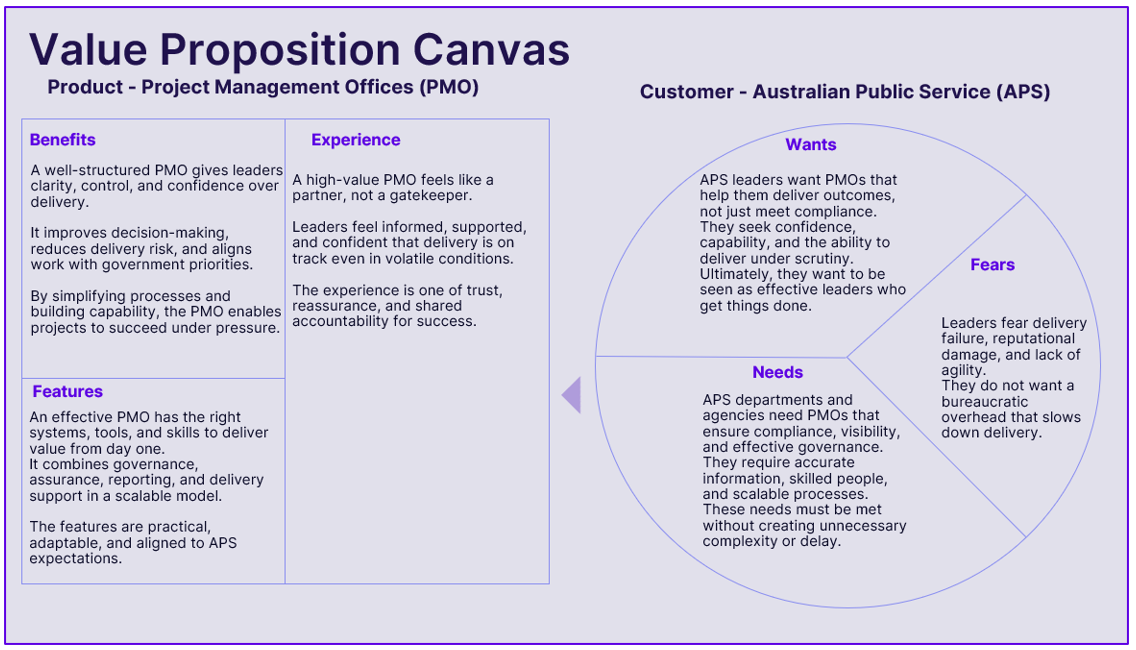
Project Management
Government delivery has never been more complex. Policy priorities shift throughout project or program delivery, budgets are tightened, emerging technologies cause disruption, and teams restructure at a fast pace. Uncertainty is not going away. The challenge for agencies is not how to eliminate it, but how to build resilience so that projects, programs, and people can thrive in spite of it.
For many, the Project Management Office (PMO) has been seen as an administrative layer, a compliance checkpoint, or a collector of status reports. In practice, when resourced and empowered, it becomes something much more valuable. At its best, it is the Peace of Mind Office, providing clarity, confidence, and continuity in an unpredictable environment.
It is easy to define a PMO by its functions such as governance, reporting, risk management, and assurance. But a more useful perspective is to consider it through a Value Proposition Lens.
When the PMO is treated as a product and the public sector as its customer, its role becomes clearer. As per the Value Proposition Canvas diagram below; the product side encompasses the benefits it delivers, the experience it creates, and the features it provides. The customer side reflects the aspirations of leaders, the needs of various departments and agencies, and the fears that influence decision-making.

This framing highlights the difference between a PMO that enables resilience and one that simply ticks compliance boxes. Leaders want impact and credibility, they need decision-ready information and trusted frameworks, and they fear failure, wasted resources, and reputational damage. A well-positioned PMO addresses these directly, while a poorly supported one risks amplifying them.
The value of a PMO is seen not only in what it delivers, but in how it shapes the experience of delivery. Organisations that position PMOs as trusted partners create cultures of openness, where project managers feel safe to escalate risks early and leaders feel supported rather than scrutinised. This shift from defensiveness to collaboration is where resilience begins to take hold.
Capability is the defining factor. Skilled staff transform the PMO from a reporting channel into a trusted advisor. A clear mandate allows it to influence decisions rather than simply reflect them. When these conditions are in place, the PMO provides foresight when priorities change, reduces risk under scrutiny, and enables leaders to make confident and credible choices.
Adaptability also matters. Delivery approaches across government have shifted significantly, with many Information Technology based projects moving away from traditional Waterfall methods towards Agile or hybrid models. These shifts offer opportunities for greater flexibility and responsiveness, but they also create new challenges, including increased documentation, additional approvals, and the need to balance agility with assurance. PMOs play a critical role in navigating this transition. By embedding governance frameworks that are scalable, proportionate, and responsive to context, they allow agencies to capture the benefits of Agile without losing the discipline required for accountability and oversight.
Examples from recent government initiatives that have demonstrated this outcome:
These are practical outcomes that reflect the difference a strong PMO can make.
Public sector leaders want PMOs that are enablers of outcomes, not blockers of progress. They need compliance and governance that do not drown delivery in red tape. They are concerned about reputational damage from failed projects, the strain of under-resourced PMOs, and delays when timely advice is needed.
Meeting these aspirations, needs, and concerns requires more than just focusing on the delivery processes. It requires PMOs that build strong relationships, tailor frameworks to project context, and provide reliable information at the right time. Above all, it requires capability. Without skilled staff, the PMO charter risks being watered down, reducing its ability to influence and increasing the risks it is meant to manage.
PMOs tend to operate in a landscape defined by uncertainty, shifting priorities, and an increasing demand to do more with less. Organisations are moving away from rigid Waterfall delivery models toward Agile or hybrid approaches, requiring PMOs to evolve from traditional oversight functions to dynamic enablers of delivery. PMOs will need to provide flexible governance frameworks that support both speed and accountability, acting as a bridge between leadership and delivery teams.
Key takeaways from recent observations highlight that PMOs must:
Looking forward, PMOs that embrace flexibility, value creation, and adaptive governance will be best placed to support organisations in navigating complexity, uncertainty, and accelerated change. The PMO is no longer just a control function; it provides practical support to keep projects on track and the organisation responsive.
Our team of big thinkers will work closely with you to deeply understand your challenges and create lasting impact. For us that means building capability, doing work that's part of something bigger, and reflecting the best of what consulting can be to uplift organisations and the communities they serve.